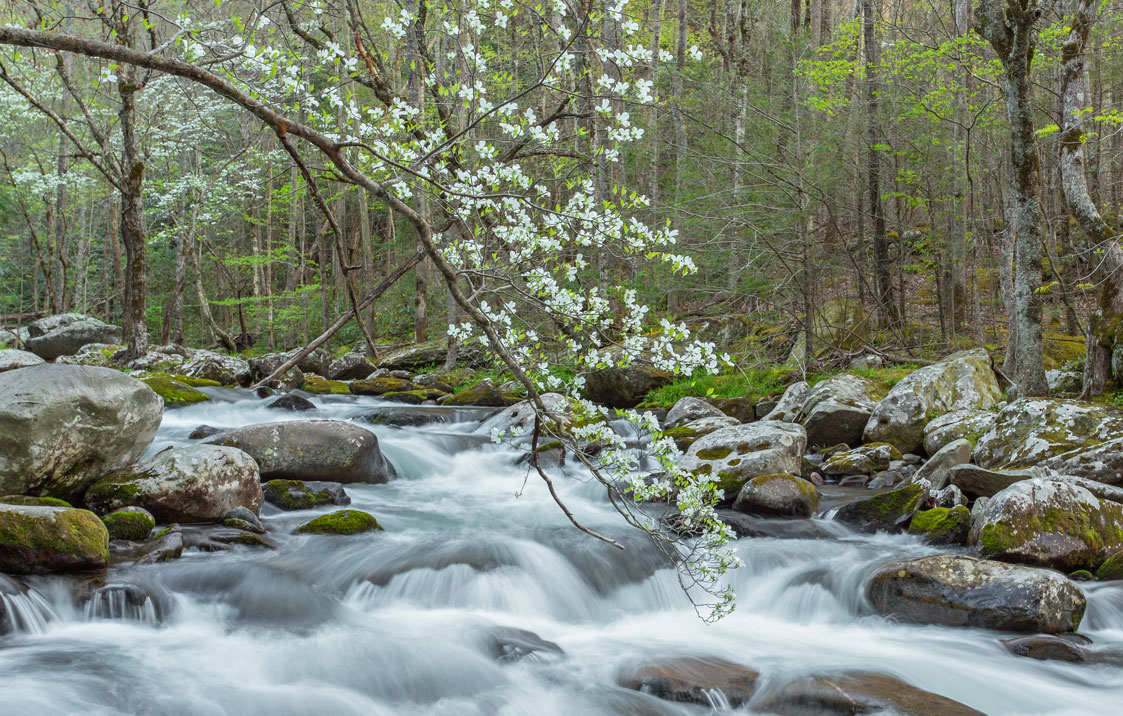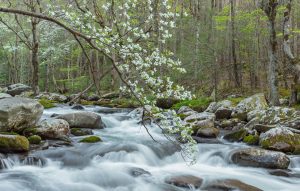

In the heart of Great Smoky Mountains National Park, the arrival of spring unveils a masterpiece, painting the landscape with rebirth and renewal. The drab landscapes of winter begin their annual transformation, gradually at first, starting late March in the deepest, lowest valleys. A quiet revelry of subtle color then slowly marches up the mountainsides, reaching the highest peaks sometime in June.
Although many revere the Smoky Mountains for their incredibly diverse wildflower blooms, I’ve found an equal measure of beauty in the park’s young foliage and the burgeoning waters.
From dogwood trees—a crowd favorite!—to magical ridgelines shrouded in fog, these mountains offer endless possibilities to the springtime photographer. Below are a few of my favorites, with suggested locations as starting points for your own exploration.
Delicate Dogwoods
Delicate dogwoods covered with cotton candy blossoms add a familiar and ephemeral adornment to the forest edges along meadows and streams. My favorite locations for photographing dogwoods include Cades Cove and the Tremont/Middle Prong area, each offering a slightly different take on this much-loved tree.
Cades Cove, with its many meadows and forest edges, is a wonderful place to capture the dogwoods set against a backdrop of woodlands. Depending on the year and the timing of the bloom, the woodlands may still be bare, or they may have taken on the electric green hue of spring. Each possibility has its own special beauty. I love to wander underneath these trees and capture the flowers from below, backlit by the sun with the delicate branch patterns visible.
Middle Prong in the Tremont area of the park is another wonderful place to find dogwoods growing alongside the rushing waters. There are some very special old dogwoods along Middle Prong, bonsai-like in their appearance, with striking boulders beautifully arranged around their bases. Capturing sharp blooms against a backdrop of silky water can be challenging, and works best on still days so the blooms aren’t in motion. Low-contrast light is necessary to capture the delicate details in the white blossoms, so wait for overcast or even rainy days to find a soft, even light. Working at the edges of the day is an option too, before sunlight starts dappling the trees and water.
Waterfalls & Rushing Streams
As winter thaws and spring rainstorms breathe life into the landscape, the waters of the Smokies gain momentum, tumbling down the ancient rocks and waterways in an exhilarating display of nature’s power. The symphony of sounds and brightly colored foliage invites photographers to weave their own visual tales of the fleeting and enchanting beauty that defines spring in this majestic wilderness.
Middle Prong is my go-to location for tumbling waters, and is easily accessed from Tremont Road or further upstream from the trail. I love to frame the flowing water with greens above in the canopy and below on the mossy rocks. Using the reflections in the many pools and potholes in the rocks can be a nice way to bring greens down into the bottom of your frame, too.
Waterfalls are a mainstay of spring photography in this park, and there are plenty to choose from, many of them very busy. Consider getting off the beaten path and head to a quiet corner away from the crowds. Big Creek is on the eastern side of the park, not far from the Tennessee-North Carolina border. Park near Big Creek Campground and take Big Creek Trail for an endless supply of creek scenes and two waterfalls: Midnight Hole and Mouse Creek Falls. Mouse Creek Falls has the advantage of being framed by rhododendrons, an evergreen shrub, so even if you’re a little early in the spring, this is always a lovely, lush falls to photograph.
Unexpected Reds and Oranges
The spring foliage of this mountain range offers colors beyond the obligatory greens. In some years, the reds and oranges in the forest canopy can rival those of fall. Dogwood, red oak, red maple—all of these species can be intensely red in the early spring. This is caused by anthocyanin pigments, evident in the newest stages of growth before chlorophyll is formed and gives the leaves their green color. It’s a mirror to what happens in fall, when chlorophyll pigments degrade and allow red anthocyanin to show through. I love this unexpected phenomenon, and including these reds and oranges in your spring images can be a lovely counterpoint to the electric greens we all expect to see.
Frosty Mornings
Early spring weather can be highly unpredictable, with frosty mornings possible until mid-season. I especially love to capture the old sentinel trees of Cades Cove, still in their winter state, coated in frost and catching the early light as it streams down the length of the valley. These winter forms tell an important part of the story of spring for me, and including them in my spring portfolios anchors the collection, providing a sense of time and progression.
Newborn Oak Leaves
One morning in early May, after a night of heavy rain and cool temperatures, I headed into Cades Cove with my camera. Fog lay heavily along Hyatt Lane, as it often does this time of year when things are moist and the air is still cool. Just the peaks of the mountains were visible above the thick layer of fog.
There’s a well-loved grandfather oak in a meadow here that was just beginning to show the palest green haze as it brought forth newborn leaves. Over the course of the next few days, the leaves would fully emerge in shades of pale pink and even paler green, covered in a soft velvet fluff, raindrops perched delicately on top. Every day I returned to the tree, watching it slowly awaken from its winter slumber. I discovered that the colors of newborn leaves are spring’s most delicate. Seeing this process unfold before my eyes was remarkable, almost as though I’d been let in on one of nature’s secrets. I had literally witnessed the birth of leaves, and now I know and treasure the secret of their particular color.
Foggy Ridgelines
I have a deep and abiding love for fog, and so spring in the Smokies is a dream for me. Spring storms create precipitation fog, leaving a song of hanging clouds to catch the light and hum in my own imagination.
Morton Overlook is my go-to location after a clearing thunderstorm. There’s something unusual about the orientation-elevation combination here that makes it especially prone to catching and holding onto the fog that so often forms in these mountains. Late in the day, the sun can backlight the fog as it dances among the spruce-hemlock forests growing along the ridgelines, and the unique, graphic shapes of the trees add interest and texture. This type of fog can move around quickly, so be prepared to compose and shoot rapidly as soon as you notice interesting compositions. Very often, scenes that catch my eye are gone in a moment or two as the fog swirls around, constantly hiding and then revealing the silhouettes of trees.
Coda
The season of rebirth and renewal transforms the Great Smoky Mountains into a visual symphony. Our images can tell the whole story of this transition, each one like an individual note or brushstroke. Rushing streams and waterfalls add movement to this living masterpiece, their sounds echoing through the valleys in harmony with the place. The spring reds and oranges, as well as the most delicate of greens, infuse the landscape with a tapestry of color. And the fog that dances along the ridgelines in the wake of a clearing storm adds a sense of magic to it all. Spring photography in the Smokies can go beyond the blossoms that so quintessentially represent this season to include a litany of subjects, from rushing streams to frosty trees to newborn oak leaves. This spring, try expanding your own photographic canvas a little: look in unexpected places for the details that help tell the whole story of this magical time of transition.
Subscribe to get the latest posts sent to your email.
The Great Smokies Welcome Center is located on U.S. 321 in Townsend, TN, 2 miles from the west entrance to Great Smoky Mountains National Park. Visitors can get information about things to see and do in and around the national park and shop from a wide selection of books, gifts, and other Smokies merchandise. Daily, weekly, and annual parking tags for the national park are also available.